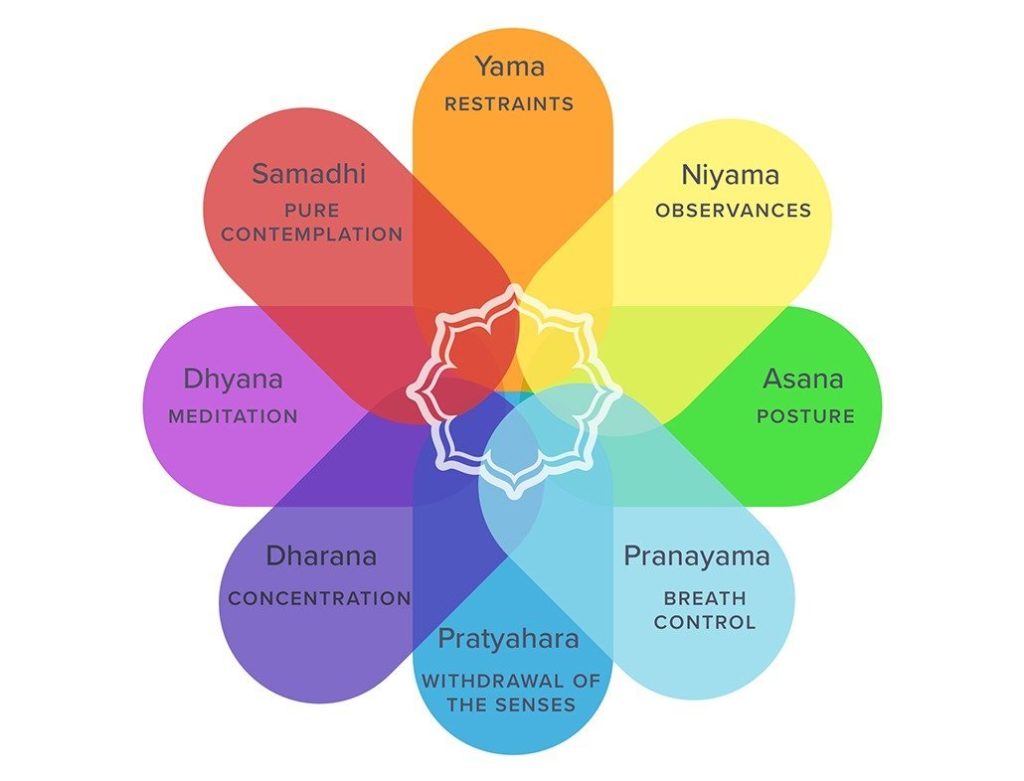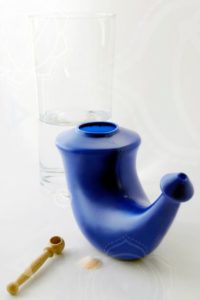The jal neti kriya, also known simply as jal neti or neti-potting, is one of the key practices of shatkarmas. The shatkarmas are six purification practices fundamental to the Hatha yoga tradition. Jal neti is a powerful technique that cleanses the nasal passages, boosts the immune system and generally improves the movement of breath for a feeling of overall vitality ✨
This practice is linked to the yogic value of purification (more on that later). Beyond the therapeutic effects of using a neti pot, the idea of clearing the body and mind is an incredibly powerful principle that is key to yoga on the whole. So..what does that really mean? In this article, we’ll go over the A to Z of neti, how to do it safely and effectively, and the other shatkarmas at the heart of hatha yoga.
What is Jal Neti Kriya?
For every yogi living a yogic lifestyle, the simple act of cleansing is super important! The Hatha yoga tradition has provided several mental-body purifying practices called the shatkriyas, among which we find two nose cleansing techniques, the netis:
- Sutra neti; cleansing with beeswax thread
- Jala neti; cleansing with saline solution
Both of them are used to prevent upper respiratory tract infections and clear the nasal passage, but they’re a bit different. The sutra neti is done by using a “sutra”, a special thread often dipped in beeswax, which is passed through the nostrils and out of the open mouth.
You basically hold each end of the thread and gently pull it back and forth to remove blockages from the nose. So… kind of like using dental floss, but less pleasant 😅
Jal neti is by far the more popular technique. It’s gentler and a bit more effective. In jal neti, also known as nasal irrigation, a small pot (known as the jal neti lota or jal neti pot) resembling a little watering can is used to bathe the nasal passages and clean the sinuses with salty water. It’s a simple yet miraculous technique that’s usually practiced in the morning to clear the gunk that collects in the sinuses overnight. If you have allergies or are prone to getting a stuffy nose, neti-potting is a must-try.
Benefits of Jal Neti
Yogis have been using this technique for centuries to prevent respiratory disease and allergies. Today, neti-potting is recommended widely by medical professionals in the west, and it’s pretty easy to find some form of a neti pot in your standard local pharmacy (if not, you’ll definitely find one in a health store).
Recent clinical trials have proven that jal neti might also have beneficial effects on our mental health! I recommend doing a quick jal neti wash in the morning before eating, brushing teeth, or meditating. The warm water helps you to wake up and removes blockages that can make you a bit cranky.
If you’re not a morning person, you might become one using a neti pot. Here are some of the other benefits of jal neti:
- Flushes out foreign bodies, excess mucus, and toxins
- Prevents allergic rhinitis and middle ear infections
- Acts like a shield against sinusitis
- Cleanses the sinuses
- Improves symptoms of asthma
- Relieves sinus-related headaches
- Clears mental sluggishness and enhances concentration
- Reduce depression and anxiety
- Cleanses the tear ducts and visual clarity
When You Shouldn’t Use A Neti Pot
There are some precautions you should consider before adding jal neti kriya to your morning routine. First and foremost, remember that when you practice jal neti, you need to breathe only through the mouth. There’s no harm in swallowing a bit of salty water, but it’s not that pleasant. Aaaand – always measure the salt you add to your neti pot. Using both too much and too little salt can irritate the sinuses and make it difficult to pass the liquid through. Here are a few groups who are also best advised to avoid neti potting, or speak with a doctor first:
- Adult patients affected by high blood pressure should either avoid using a neti pot, because it may induce dizziness, or seek advice from a medical expert
- People who suffer from frequent ear infections should avoid jal neti
- People who have recently undergone ear or nose surgery should avoid performing jal neti. Consult your surgeon and care providers before starting a neti routine.
- Anyone affected by chronic bleeding should avoid neti
How to Do Jal Neti (Neti Kriya)
There are sooo many neti pots to choose from, online and in your local pharmacy. From budget options made of plastic to more refined ones in beautiful ceramic, there’s really something for all tastes! Ideally, look for something that’s a good combination of efficiency and quality. I recommend plastic or metal because you can feel the water temperature through the material and make sure it’s just right (the sinuses are really sensitive).
Apart from the pot, these are the essential elements you should add to your list before you try to practice the jal neti kriya:
- Nasal salt*
- Measuring spoon
- Towel
- Purified lukewarm water
*Buy salt specific for nasal irrigation in your drugstore. DON’T use just any old salt – it can contain trace elements of metals and other icky things you don’t want in your nose!
This is how to do a neti cleanse, step by step:
- Wash your neti pot thoroughly before us. Follow the instructions on your neti pot to find the correct amount of salt to use.
- Fill your neti pot with purified, lukewarm water. It should be slightly cooler than what you’re comfortable showering in – as close to body temperature as possible.
- Dissolve the correct amount of nasal salt into lukewarm water.
- Position yourself standing in front of a sink.
- Starting with the nostril that’s less clogged, place the tip of the neti pot into the nostril, and gently lean forward over the sink.
- Tilt your head away from the neti pot and let the warm water flow through your nasal passage, allowing the water to drain into the sink.
- Breath only through the mouth. Take calm and slow breaths while doing every action with full awareness.
- Stop when you’ve poured half of the water through the nose. Then, blow your nose gently.
- Repeat the same process on the other side.
- Blow your nose completely.
This can take a few tries to get right, so just be patient! I always like to carry a pack of tissues with me after I neti, because it takes some time to clear the nasal passage entirely of water. Keep it clean and enjoy the clear-headedness!
Why Cleansing Practices Matter in Yoga

The principle of saucha, meaning purity, is the first of the four niyamas mentioned in one of the foremost texts in yoga; Patanjali’s yoga sutras. The niyamas are one of eight branches of yoga practice, and they’re widely understood as observances.. things we should try to cultivate in our life.
The yogic concept of purity includes keeping a tidy space and caring for yourself, but also extends to pure thought and action. The aim in observing saucha is to live a pure, peaceful and joyful life.
There are a number of other yogic cleansing practices that compliment jal neti. These include asana, pranayama, mudras, and bandhas. The bandhas are energy locks performed to channel energy to specific areas of the body. The mudras also have powerful purifying effects, and are used in higher levels of yoga practice to intensify the benefits of certain yoga asanas or focus the benefits in a specific way.
Mudras are powerful hand gestures that act as “energetic seals of authenticity” (the direct translation of mudra is often seal). If there’s one deeply therapeutic mudra that aims to cleanse the body, it’s lotus mudra.
This gesture is usually performed to open the heart center, the Anahata chakra, inviting love, compassion, and purity into our being. In this mudra, the hands recreate the beautiful shape of a lotus flower and the gesture is done by placing the base of the palms together in front of the chest, while the thumbs are connected to each other and pinkies touch.
Shatkarma in Hatha Yoga
According to the Hatha Yoga Pradipika, one of the major texts of the yogic system, there are six purification procedures, originally called shatkarmas. These practices are designed to deeply cleanse the entire system. Just like neti, the shatkarmas remove impurities and toxins from the whole body, preventing a number of diseases, while harmonizing mind, body, and soul.
Some of the shatkarmas today sound like bizarre circus tricks! We’ve obviously come a long way in understanding the body and how to aid its natural defenses. For a good dose of historical reference, here are the shatkarmas:
- Jal Neti is the cleansing of the nasal passages. We’ve got this one covered 😉
- Dhauti (don’t try this at home) aims to clean the entire digestive system of lingering food, excess mucus, hence helping to prevent gas, acidity & indigestion. It was traditionally performed by slowly swallowing a damp cloth about seven meters long and then withdrawing it. My advice? Try a dietary cleanse for gut health instead.
- Naulī is a self-administered abdominal massage, which is similar to the uddyiana bandha, the abdominal lock, and it’s performed only by using the abdominal muscles. It takes insane control of abdominal muscles but in exchange, it helps to strengthen the abdominal walls and regulates blood pressure. To do it, the practitioner needs to stand with the feet about hip-width apart, the hands are on the knees, the upper part of the body leans forward while moving the abdominal muscles alternately in a clockwise, then in an anticlockwise direction.
- Basti is colonic irrigation that allows us to completely clean out the colon. Through an enema, the water is pushed around into the large intestine and makes the passage unobstructed for undigested food, hence helping in indigestion and all sorts of gastric issues.
- Kapālabhātī (AKA shining skull/breath of fire) is probably one of the most common breathing techniques designed to energize the entire body and mind while balancing the chakras. It consists of a rhythmic series of short out-breaths, where the belly is sucked in forcefully and the inhalation is completely passive. This is essential to the Kundalini tradition, and I highly recommend trying it if you haven’t!
- Trataka is a meditation technique that is performed by simply gazing at one fixed point, usually a spot or a candle flame performed to improve concentration.
Free Your Prana
On a more subtle level, we can imagine purifying the energy body when we practice such techniques. Purifying practices energetically clear the nadis, or channels where prana, our life force energy flows. When prana gets stuck, we experience discomfort, creating fertile ground for illnesses, frustration, and tension to grow.
However, when prana flows freely through the nadis, not only do we experience a sense of great liberation, but most importantly, we’re actually preparing the body, mind, and soul to enter a state of pure, blissful awakening. And that is, as we know, the purpose of yoga!
Next Steps
- Take my History of Yoga Course to learn all about yogic principles and how they are applied to daily life!
- Order my Yoga Life book for a practical guide to applying yogic principles to your life and constitution.
- Check out my Yoga Philosophy knowledge hub for more inspiring content
- Join Uplifted for exclusive content that you can access right from the app. Take a deep dive into your practice with me this year!
Experience 3 Training Videos from Inside My 200-Hour Online YTT

YOU MIGHT ALSO LIKE
- What is Kriya Yoga? The Philosophy and Practice
- Uddiyana Bandha: Tapping Into Your Deep Core
- 4 Reasons Hasta Bandha Is Essential To Your Yoga Practice
- Vitarka Mudra: What It Is and How Do You Use It?
- Shakti Mudra: What It Is and How Do You Do It?
- Garuda Mudra: What It Is and How Do You Use It?
- Kali Mudra: What It Is and How Do You Do It?
- Shunya Mudra: What It Is and How Do You Do It?
- Varuna Mudra: What It Is and How Do You Use It?
- Vayu Mudra: What It Is and How Do You Use It?
- Samana Vayu: The Energy of Balance & How to Access It
- Apana Vayu: The Energy of Release & Surrender
- Udana Vayu: The Ascending Wind
- Prana Vayu: The Breath of Vitality
- Vyana Vayu: The Energetic Secret to Flow















